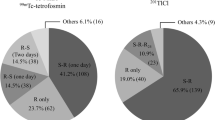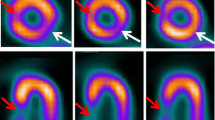Abstract
Background
Ionizing radiation generated during medical imaging procedures is a matter of concern. However, the current status of radiopharmaceutical use in stress myocardial perfusion imaging (MPI) and the radiation exposure from these radiopharmaceuticals is unknown in Japan.
Methods and Results
A nationwide survey was conducted from June through July 2016. The questionnaires on the radiopharmaceuticals used and their administered doses during stress MPI were sent to 641 nuclear medicine facilities. The responses were collected from 431 facilities and the effective dose (ED) for an adult with standard body weight was calculated. Forty-three percent of the facilities used only 201TlCl, 35% used only 99mTc radiopharmaceuticals, and the remaining 22% used both. The two main reasons for using 201TlCl instead of 99mTc radiopharmaceuticals were “more familiarity with the usage of 201TlCl than 99mTc radiopharmaceuticals” and “apprehension about increasing the burden of physicians performing tracer injection twice.” The mean ED was 14.0 ± 5.5 mSv (range, 3.9 to 25.2 mSv), which was higher than that reported in other countries.
Conclusions
The ED of stress MPI radiopharmaceuticals in Japan is probably higher than the world standard because more than 50% of the facilities still use 201TlCl. We recommend revising the routine stress MPI protocol to reduce the effects of ionizing radiation.





Similar content being viewed by others

Abbreviations
- MPI:
-
Myocardial perfusion imaging
- ASNC:
-
American Society of Nuclear Cardiology
- ED:
-
Effective dose
- J-RIME:
-
The Japan Network for Research and Information on Medical Exposures
- DRL:
-
Diagnostic reference level
- IAEA:
-
International Atomic Energy Agency
- INCAPS:
-
International Atomic Energy Agency Nuclear Cardiology Protocols Cross-Sectional Study
References
Carpeggiani C, Picano E, Brambilla M, Michelassi C, Knuuti J, Kauffman P, et al. Variability of radiation doses of cardiac diagnostic imaging tests: The RADIO-EVINCI study (RADIationdOse subproject of the EVINCI study). BMC Cardiovasc Disord 2017;17:63.
Lecchi M, Malaspina S, Scabbio C, Gaudieri V, Del Sole A. Myocardial perfusion scintigraphy dosimetry: Optimal use of SPECT and SPECT/CT technologies in stress-first imaging protocol. Clin Transl Imaging 2016;4:491-8.
Becker MD, Butler PF, Bhargavan-Chatfield M, Harkness BA, Metter D, MacFarlane CR, et al. Adult gamma camera myocardial perfusion imaging: Diagnostic reference levels and achievable administered activities derived from ACR accreditation data. J Am Coll Radiol 2016;13:688-95.
Jerome SD, Tilkemeier PL, Farrell MB, Shaw LJ. Nationwide laboratory adherence to myocardial perfusion imaging radiation dose reduction practices. JACC Cardiovasc Imaging 2015;8:1170-6.
Inubushi M, Higashi T, Kuji I, Sakamoto S, Tashiro M, Momose M. Introduction of nuclear medicine research in Japan. Eur J Nucl Med Mol Imaging 2016;43:2449-52.
Okuda K, Nakajima K, Matsuo S, Kondo C, Sarai M, Horiguchi Y, et al. Creation and characterization of normal myocardial perfusion imaging databases using the IQ·SPECT system. J Nucl Cardiol 2017; doi:10.1007/s12350-016-0770-2.
Watanabe H, Ishii K, Hosono M, Imabayashi E, Abe K, Inubushi M, et al. Report of a nationwide survey on actual administered radioactivities of radiopharmaceuticals for diagnostic reference levels in Japan. Ann Nucl Med 2016;30:435-44.
Einstein AJ, Pascual TN, Mercuri M, Karthikeyan G, Vitola JV, Mahmarian JJ, et al. Current worldwide nuclear cardiology practices and radiation exposure: Results from the 65 country IAEA Nuclear Cardiology Protocols Cross-Sectional Study (INCAPS). Eur Heart J 2015;36:1689-96.
Mercuri M, Pascual TN, Mahmarian JJ, Shaw LJ, Rehani MM, Paez D, et al. Comparison of radiation doses and best-practice use for myocardial perfusion imaging in US and Non-US laboratories: Findings from the IAEA (International Atomic Energy Agency) nuclear cardiology protocols study. JAMA Intern Med 2016;176:266-9.
Lindner O, Burchert W, Schäfer W, Hacker M. Myocardial perfusion SPECT 2015 in Germany. Results of the 7th survey. Nuklearmedizin 2017;56:31-8.
Lindner O, Pascual TN, Mercuri M, Acampa W, Burchert W, Flotats A, et al. Nuclear cardiology practice and associated radiation doses in Europe: Results of the IAEA Nuclear Cardiology Protocols Study (INCAPS) for the 27 European countries. Eur J Nucl Med Mol Imaging 2016;43:718-28.
Jiang Z, Liu Y, Xin C, Zhou Y, Wang C, Zhao Z, et al. Normal stress-only myocardial single photon emission computed tomography predicts good outcome in patients with coronary artery stenoses between 40 and 70. Nucl Med Commun 2016;37:899-903.
Palyo RJ, Sinusas AJ, Liu YH. High-sensitivity and high-resolution SPECT/CT systems provide substantial dose reduction without compromising quantitative precision for assessment of myocardial perfusion and function. J Nucl Med 2016;57:893-9.
SNMMI, ASNC, IAC and Nuclear Cardiology Dose. J Nucl Med 2017;58:15N.
Acknowledgments
We would like to thank everyone in the nuclear medicine facilities who responded to this survey and to Hiroshi Watanabe, Department of Radiological Technology, Japan Labour Health and Welfare Organization, Yokohama Rosai Hospital, for his valuable advice.
Disclosure
The authors have indicated that they have no financial conflict of interest.
Author information
Authors and Affiliations
Corresponding author
Additional information
All editorial decisions for this article, including selection of reviewers and the final decision, were made by guest editor Nagara Tamaki, MD.
Rights and permissions
About this article
Cite this article
Otsuka, R., Kubo, N., Miyazaki, Y. et al. Current status of stress myocardial perfusion imaging pharmaceuticals and radiation exposure in Japan: Results from a nationwide survey. J. Nucl. Cardiol. 24, 1850–1855 (2017). https://doi.org/10.1007/s12350-017-0867-2
Received:
Accepted:
Published:
Issue Date:
DOI: https://doi.org/10.1007/s12350-017-0867-2



